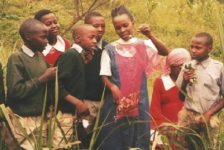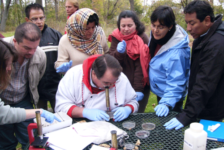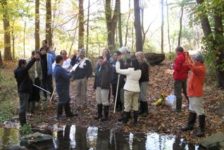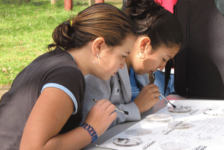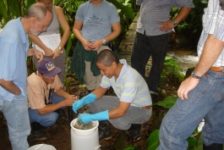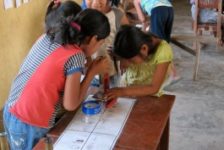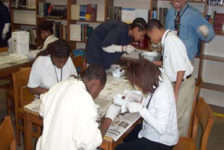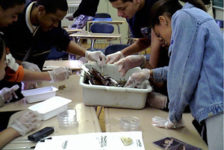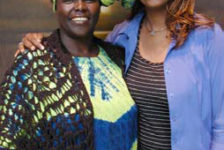“You can easily evade responsibility, but you cannot escape the consequences.” — Josiah Charles–Stamp.
In this issue: How Do Scientists Tie A Leaf Pack?; Idaho State University Brings Leaf Pack Experiments To High School Students; Leaf Pack Goes International Again!
How Do Scientists Tie A Leaf Pack? Teachers Want to Know
We have heard from many of you over the years that have lost leaf packs during high stream flow events.
Here is a description and a couple of images showing how Stroud Water Research Center Director Dr. Bern Sweeney ties leaf packs in the often “flashy” Brandywine Creek in Delaware.
- Create leaf pack (LP) and loop the twine through on
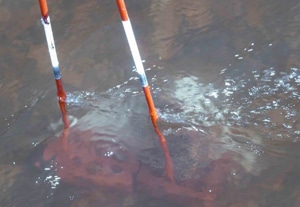 e of the holes in the brick. Tie it tight.
e of the holes in the brick. Tie it tight. - Loop twine through the other end of the LP and through another hole on the brick. You must fasten both ends of the leaf pack so it does not flap back and forth in the stream. This is true whether you tie it to a rock or on bricks. (The two brick pieces in this picture truly make up one brick, as they are half pieces.)
- Within the riffle area place brick parallel to stream flow/stream bank (versus perpendicular). The chances of the brick flipping lengthwise are minimized with this placement.
- Drive the pole or bar (we used snow markers) through one of the holes in the bricks and if possible through the leaf pack. It serves as another reinforcement.
Keep in mind that this technique does not need to be replicated in very small streams where tying the leaf pack securely to a rock should be fine.
If in doubt, this is the recommended technique. Have you developed your own technique? Please share it with us!
Leaf Pack Thanks
We would like to thank Bob Connick at Mahopac High School in Mahopac, NY for inviting and hosting us as we offered three Leaf Pack workshops this past summer! This gave us an opportunity to train 45 individuals and lots of new LPN data to look forward to!
In this season of thanksgiving, we would like to thank LaMotte Company for making it possible for us to attend conferences this fall!
Did You Know …?
The United Nations has designated 2005-2015 as the decade of WATER FOR LIFE.
“Each year more than 1 billion of our fellow human beings have little choice but to resort to using potentially harmful sources of water.
Two out of 10 people do not have a source for safe drinking water … it is a unique occasion not just to highlight the magnitude of the problem, but also to bring all stakeholders together to apply solutions that work.”
Major efforts are being made “to cut in half by 2015 the proportion of people without sustainable access to safe drinking-water and basic sanitation.”
For the next 10 years, we have an opportunity to focus our attention on protecting and respecting our water resources as individuals, communities, countries, and as a global family of concerned citizens.
For more information, visit: http://www.un.org/waterforlifedecade/
Idaho State University Brings Leaf Pack Experiments To High School Students
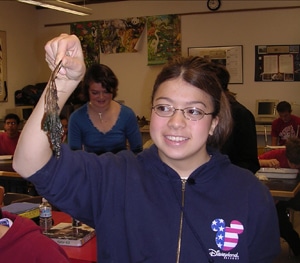
Idaho students have been investigating the ecology of their local streams by designing their own experiments using leaf packs.
Jessica DelMonte and Eric Rude were partnered through the National Science Foundation’s GK-12 Project, which is designed to enhance science curricula for K-12 classrooms. Their goal is to increase both student understanding of how science is done and the actual amount of learning that takes place by using the local environment to spark students’ interest.
Last fall, tenth grade biology students performed their own experiments in two local streams, City Creek and Pocatello Creek. The students asked questions about the factors that affect the decomposition of leaves that fall into the streams, and then designed leaf pack experiments to answer those questions.
One group of students found that where the leaves settle in the stream influences the decomposition rate, with leaves in faster flowing water decomposing at a faster rate.
By guiding students through the same process that scientists often go through to gain new knowledge, we allow them to make discoveries for themselves.
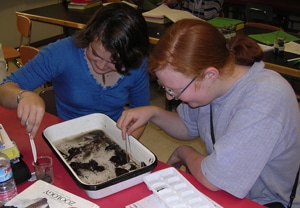
Through their leaf pack experiments, Idaho students have gained a working knowledge of the ecology of their local streams. The success of the leaf pack experiments sparked interest in other local teachers, who will include the inquiry-based activities in their classrooms this fall.
Jessica will complete her Doctor of Arts in Biology in May 2006 under Dr. G. Wayne Minshall at ISU’s Stream Ecology Center and plans to teach biology at the university level next fall. She has worked with several educators to incorporate inquiry based ecology lessons in both high school and college biology classrooms. This year, Jessica is helping four teachers and over 200 students conduct leaf pack experiments in Southeast Idaho (Columbia River Watershed).
Leaf Pack Goes International Again!
“Water quality, Ecosystem Function, Leaf Packs and Students: Making the Connection in North America”
This past July, Stroud Water Research Center Director Bern Sweeney, Ph.D., traveled to France to give a keynote address to fellow scientists studying leaf litter breakdown in aquatic ecosystems. He was able to present the Leaf Pack Experiment and the Network to scientists from all over the globe!
Many scientists expressed interest in the experiment and in the network. We look forward to seeing international leaf pack sites on Leaf Pack Network® soon!



